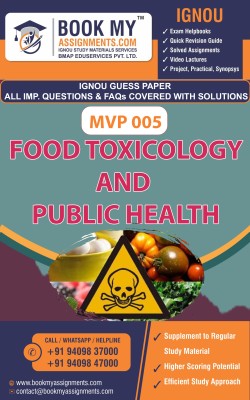IGNOU MVP 005 Food Toxicology and public health | Guess Paper | Important Question Answer |Master of Science in Food Safety and Quality Management (MSCFSQM)(Paperback, BMA Publication)
Quick Overview
Product Price Comparison
Introduction to Food Toxicology:Overview of food toxicology as a field of study, its significance in public health, and its relevance to the food industry.Understanding the principles of toxicology, including dose-response relationships, toxicity testing, and risk assessment.Sources of Foodborne Toxins:Examination of natural and man-made sources of toxins in food, including microbial toxins (e.g., bacterial toxins, fungal toxins), chemical contaminants (e.g., pesticides, heavy metals), and environmental pollutants (e.g., industrial chemicals, toxins in seafood).Types of Foodborne Toxins:Study of different types of foodborne toxins and their effects on human health, including acute toxins (e.g., bacterial toxins causing food poisoning), chronic toxins (e.g., carcinogens, neurotoxins), and allergens.Mechanisms of Toxicity:Understanding the mechanisms by which foodborne toxins exert their toxic effects on the human body, including absorption, distribution, metabolism, and excretion.Study of the molecular and cellular mechanisms underlying toxicity, such as enzyme inhibition, oxidative stress, and DNA damage.Toxicological Risk Assessment:Overview of the risk assessment process used to evaluate the potential health risks associated with exposure to foodborne toxins.Understanding of hazard identification, dose-response assessment, exposure assessment, and risk characterization in toxicological risk assessment.Foodborne Illnesses and Outbreaks:Examination of common foodborne illnesses caused by toxins in food, including bacterial food poisoning (e.g., Salmonella, E. coli), mycotoxin poisoning (e.g., aflatoxins), and chemical poisoning (e.g., heavy metal contamination).Case studies of foodborne outbreaks and their impact on public health, food safety regulations, and consumer confidence.Regulatory Framework for Food Safety:Overview of food safety regulations and regulatory agencies responsible for monitoring and regulating foodborne toxins.Understanding of regulatory standards, limits, and guidelines for toxins in food, including maximum residue limits (MRLs) for pesticides, food additive regulations, and limits for contaminants in food.Prevention and Control of Foodborne Toxins:Strategies for preventing and controlling foodborne toxins in the food supply chain, including good agricultural practices (GAPs), good manufacturing practices (GMPs), and hazard analysis and critical control points (HACCP).Implementation of surveillance systems, monitoring programs, and food safety interventions to reduce the risk of foodborne toxin contamination.Emerging Issues and Trends in Food Toxicology:Discussion of emerging toxins, food safety challenges, and trends in food toxicology, such as emerging pathogens, novel toxins, antimicrobial resistance, and climate change impacts.Exploration of research initiatives, technological innovations, and policy developments aimed at addressing emerging issues in food toxicology.

